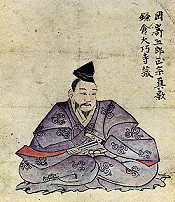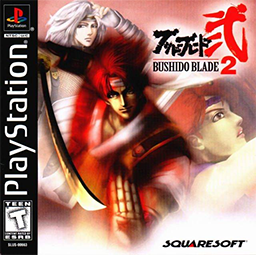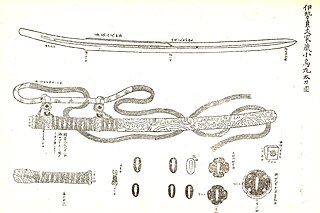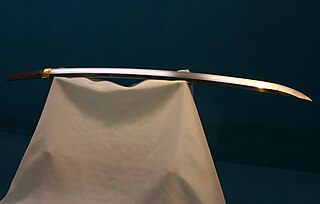
A Japanese sword is one of several types of traditionally made swords from Japan. Bronze swords were made as early as the Yayoi period, though most people generally refer to the curved blades made from the Heian period (794–1185) to the present day when speaking of "Japanese swords". There are many types of Japanese swords that differ by size, shape, field of application and method of manufacture. Some of the more commonly known types of Japanese swords are the uchigatana, tachi, ōdachi, wakizashi, and tantō.
A tachi is a type of sabre-like traditionally made Japanese sword (nihonto) worn by the samurai class of feudal Japan. Tachi and uchigatana generally differ in length, degree of curvature, and how they were worn when sheathed, the latter depending on the location of the mei (銘), or signature, on the tang. The tachi style of swords preceded the development of the katana, which was not mentioned by name until near the end of the twelfth century. Tachi were the mainstream Japanese swords of the Kotō period between 900 and 1596. Even after the Muromachi period (1336–1573), when katana became the mainstream, tachi were often worn by high-ranking samurai.

A lightsaber is a fictional energy sword featured throughout Star Wars. A typical lightsaber is depicted as a luminescent laser sword about 3 feet (0.91 m) in length emitted from a metal hilt around 10.5 inches (27 cm) in length. First introduced in the original Star Wars film, it has since appeared in most Star Wars films, with at least one lightsaber duel occurring in each installment of the "Skywalker saga". The lightsaber's distinct appearance was created using rotoscoping for the original films, and with digital effects for the prequel and sequel trilogies.

A tantō is one of the traditionally made Japanese swords that were worn by the samurai class of feudal Japan. The tantō dates to the Heian period, when it was mainly used as a weapon but evolved in design over the years to become more ornate. Tantō were used in traditional martial arts. The term has seen a resurgence in the West since the 1980s as a point style of modern tactical knives, designed for piercing or stabbing.

Gorō Nyūdō Masamune was a medieval Japanese blacksmith widely acclaimed as Japan's greatest swordsmith. He created swords and daggers, known in Japanese as tachi and tantō, in the Sōshū school. However, many of his forged tachi were made into katana by cutting the tang (nakago) in later times ("suriage"). For this reason, his only existing works are katana, tantō, and wakizashi. No exact dates are known for Masamune's life. It is generally agreed that he made most of his swords between 1288 and 1328. Some stories list his family name as Okazaki, but some experts believe this is a fabrication to enhance the standing of the Tokugawa family.
Muramasa, commonly known as Sengo Muramasa (千子村正), was a famous swordsmith who founded the Muramasa school and lived during the Muromachi period in Kuwana, Ise Province, Japan.

The nagamaki is a type of traditionally made Japanese sword (nihontō) with an extra long handle, used by the samurai class of feudal Japan.
Murasame, refers to a type of rain that falls hard, then gently, in fits and starts. In Japanese poetic tradition, it is particularly associated with the cold rains of autumn.

In mythology, legend or fiction, a magic sword is a sword with magical powers or other supernatural qualities. Renowned swords appear in the folklore of every nation that used swords.

Bushido Blade 2 is a fighting video game published by Square, released in Japan and North America in 1998. It is the sequel to Bushido Blade, which had been released the previous year. The game was re-released in 2008 for PlayStation Network.

The Japanese war fan, or tessen, is a weaponized Japanese hand fan designed for use in warfare. Several types of war fans were used by the samurai class of feudal Japan and each had a different look and purpose.

The Kogarasu Maru (小烏丸), or "Little Crow Circle", is a unique Japanese tachi sword believed to have been created by legendary Japanese smith Amakuni during the 8th century AD.

A katana is a Japanese sword characterized by a curved, single-edged blade with a circular or squared guard and long grip to accommodate two hands. Developed later than the tachi, it was used by samurai in feudal Japan and worn with the edge facing upward. Since the Muromachi period, many old tachi were cut from the root and shortened, and the blade at the root was crushed and converted into a katana. The specific term for katana in Japan is uchigatana (打刀) and the term katana (刀) often refers to single-edged swords from around the world.

Kiku-ichimonji (菊一文字), often romanized with a somewhat misplaced hyphen as Kikuichi-monji, is a collective name given to the katana made by the thirteen swordsmiths who were in attendance to the Emperor Go-Toba in 1208.
Many significant Japanese historical people of the Sengoku period appear in works of popular culture such as anime, manga, and video games. This article presents information on references to several historical people in such works.

Muramasa: The Demon Blade is a 2009 action role-playing game developed by Vanillaware and published for the Wii by Marvelous Entertainment (Japan), Ignition Entertainment, and Rising Star Games (Europe). An expanded PlayStation Vita version was published in 2013 by Marvelous AQL in Japan and Aksys Games in Western territories. Using a 2D side-scrolling perspective, the gameplay revolves around a beat 'em up fighting system, while incorporating role-playing elements such as leveling and questing.

Sengoku Basara: Samurai Kings is a Japanese anime television series based on the Capcom video game series of the same name made by Production I.G, planned and written by Yasuyuki Muto, and chiefly directed by Itsuro Kawasaki. The series started broadcast on Japan's Chubu-Nippon Broadcasting (CBC) station in April 2009; other networks broadcast the episodes within a few days, including TBS, MBS, and Animax. Its first season made its North American television debut on the Funimation Channel on November 16, 2010.
Masamune (正宗) was a Japanese swordsmith.












